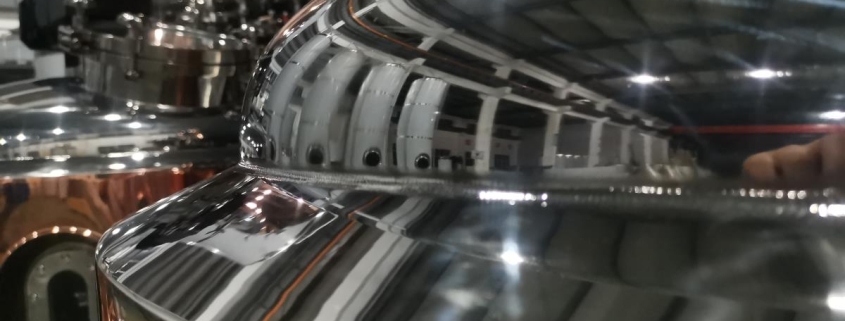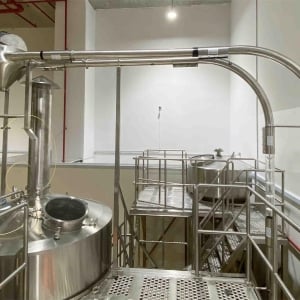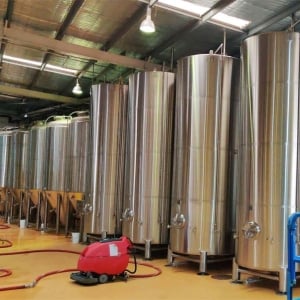5 BBL Brite Tank with Wheels
A 5 BBL Brite Tank with Wheels is a critical piece of brewing equipment used to store, settle, clarify, and carbonate beer after fermentation and before packaging. This stainless steel tank has a capacity of 5 barrels or 620 liters (164 gallons).
Brite tanks are cylindrical in shape and come in different dimensions with height usually being the variable factor. They can be customized with features like cooling jackets, variable pressure control, cleaning accessories, and wheeled bases for portability. Choosing the right brite tank ensures efficient beer processing, quality consistency, and flexibility for craft breweries.
Table 1: 5 BBL Brite Tank Equipment Guide
| Parameters | Details |
|---|---|
| Typical Capacity | 5 BBL or 620 liters or 164 US gallons |
| Construction Material | Stainless Steel Grade 316L |
| Finish | Interior: Polished Exterior: Satin or Mirrored |
| Design | Vertical Cylindrical Cone/Slope Bottom Dish Top with Manway |
| Key Features | Cooling Jacket Variable Pressure Control Cleaning/CIP Accessories Wheeled Base |
| Lead Time | 6-8 weeks custom order |
| Warranty | 12 months standard |
Types of 5 BBL Brite Tank with Wheels
There are two main types of 5 BBL brite tanks based on the cooling system:
Table 2: Brite Tank Equipment Types
| Type | Details |
|---|---|
| Glycol Jacketed | Glycol solution circulates in jacket around tank to cool beer |
| Direct Draw | External cooling connected directly to tank wall to chill beer |
Glycol Jacketed Tanks use food-grade propylene glycol solution in the outer jacket to remove heat from the beer. This indirect cooling method protects the beer from contamination. Glycol tanks require an external chiller to circulate and cool the glycol.
Direct Draw Tanks have cooling media like water, steam, or refrigerant connected directly to the outer wall of the tank via internal channels or coils. The advantage is faster cooling without glycol circuit. Care must be taken to ensure media does not contact beer.
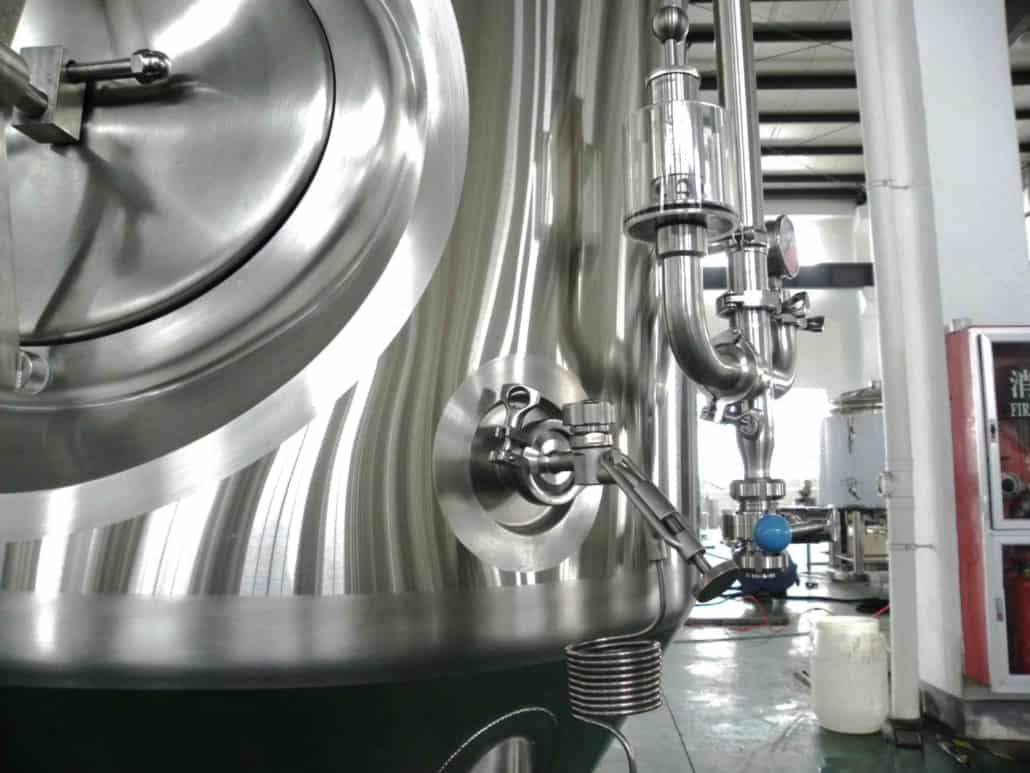
Brewing Process with Brite Tanks
In the typical brewing process, the boiled wort goes into a fermentation tank where yeast is added for alcohol production. After primary fermentation, green beer moves into the brite tank for secondary conditioning before packaging.
Figure 1. Typical brewing process with brite tank
The key functions performed in a brite tank are:
- Settling yeast and proteins for clarity
- Maturing flavor profile
- Carbonating to required CO2 volumes
- Storing and buffering beer
- Protecting beer from oxidation and contamination
Proper cleaning and sanitization of brite tanks is critical before transferring each new batch to prevent off-flavors.
Design, Layout and Customization
Table 3. 5 BBL Brite Tank Design Parameters
| Specification | Details | Customization |
|---|---|---|
| Height | 84 – 96 inches typical Lower: More stable Higher: More storage | Yes, 6-12 inch variable increment |
| Diameter | 30-36 inches typical Wider: Larger footprint | Yes, 3-6 inch increments |
| Outlets | 1.5 inch Tri-clamp connections Sample valve | Additional outlets possible |
| Sight Glass | Required | Etched Gallon Markings |
| Legs | 3 inch adjustable SS legs | Casters/wheels possible |
| Pressure Rating | 60 psi design | Higher rating available |
| Cleaning | Spray ball CIP accessories | Custom spray geometry |
| Controls | Glycol/cooling valves Pressure relief valve | Automated control system |
| Instrumentation | Thermowells for sensors Level indicators | Digital readouts extra |
| Manifold | Glycol in/out (if jacketed) | Integrated piping skid |
Shape: Cylindrical with sloped cone bottom and dished top lid
Finish: Interior polished to 150 grit sanitary finish and exterior in satin or mirrored finish
Cone Bottom Angle: 60 degrees for efficient drainage
Manway (Top Opening): 18-24 inches diameter for tank access
Variable Pressure: Ability to withstand and adjust pressures up to 60 psi for carbonation
Cooling Jacket: 1-2 inches uniform glycol space all round
Legs vs Casters: Legs for stationary use or casters for portability
Customization allows optimal dimensions, features, and accessories tailored to production requirements.
Suppliers and Price Range
Table 4. Suppliers and Price Estimates
| Supplier | Basis | Price Range |
|---|---|---|
| JV Northwest | Glycol Jacketed, Complete Skid | $16,000 – $22,000 |
| ABE | Glycol Jacketed | $18,000 – $26,000 |
| Brewmation | Direct Draw | $14,000 – $20,000 |
| Specific Mechanical | Glycol Jacketed | $15,000 – $21,000 |
| Portland Kettle Works | Direct Draw | $12,000 – $18,000 |
Landed cost including shipping and import duties extra for overseas suppliers.
- JV Northwest, ABE, Specific Mechanical offer fully customized glycol jacketed tanks with integrated piping skid options
- Brewmation and Portland Kettle Works specialize more in direct draw cooling tanks
- Chinese export suppliers on Alibaba.com offer tanks at 30-50% lower cost but reliability may be lower
- Buying complete tank with integrated cooling system and controls costs 20-30% more than basic tank
Average Price: $15,000 to $22,000 depending on supplier location, customization, and integrated peripherals
Installation, Operations and Maintenance
Table 5. Brite Tank Installation, Operation and Maintenance
| Function | Activity | Frequency |
|---|---|---|
| Installation | Leveling Glycol/cooling connection CIP setup Control wiring | One time activity |
| Operation | Inspections Cleaning/sanitization Transfers Monitoring | Each batch changeover |
| Maintenance | Gasket checks Gauges calibration Reconditioning | Annual |
Installation requires securing tank foundation, making glycol and utility connections, integrating cleaning systems and control wiring.
Operations involve visual inspections, cleaning/sanitizing protocols before and after each beer transfer, monitoring temperature/pressure etc.
Maintenance activities like reconditioning the interior finish, replacing gaskets, calibrating gauges and control sensors need to be performed periodically to maximize tank life span and performance consistency.
Choosing the Right Brite Tank Supplier
Table 6. Vendor Selection Criteria
| Parameters | Evaluation Tips |
|---|---|
| Reputation | Reviews, years in business, client list |
| Quality | Material certificates, fabrication finish, site audit |
| Lead Time | Production capacity, inventory status, responsiveness |
| Customization | Dimensional flexibility, feature options, peripheral integration |
| Cost | Pricing models, shipping terms, payment modes |
| Support | Installation assistance, operator training, maintenance manuals |
- Review company website content, social media, client testimonials
- Validate any quality certifications and compliance standards
- Understand standard vs custom offerings, additional costs
- Evaluate inventory and historical delivery timelines
- Discuss budget, shipment terms, warranty coverage
- Ensure good documentation and responsive account management
Choose supplier based both on product quality match and service relationship comfort.
Pros and Cons of 5 BBL Brite Tanks
Table 7. Advantages and Limitations
| Pros | Cons |
|---|---|
| Optimal 5 BBL capacity | Higher capital cost than fermenters |
| Stainless steel protection | Glycol complexity in jacketed models |
| Secondary conditioning ability | Floor space requirements |
| Carbonation control | Weight limits portability without tools |
| Improved clarity and shelf life | Specialized equipment, expert operation needed |
| Storage buffer against packaging delays | CIP cleaning rigor required |
| Customization to needs | Long lead times for customization |
Key Benefits: Right capacity, metal protection, flexible control on conditioning parameters, robust storage ability make brite tanks invaluable for commercial scale craft breweries juggling multiple brands in limited floor space while maintaining quality consistency.
Main Limitations: Significant capital investment required justified only at larger production volumes; glycol-based cooling increases system complexity slightly; custom options increase lead time that must be planned for.
In summary, brite tanks, though expensive, enable improved process control, beer quality and production efficiency gains that are critical growth enablers for commercial craft breweries aiming to scale up operations.
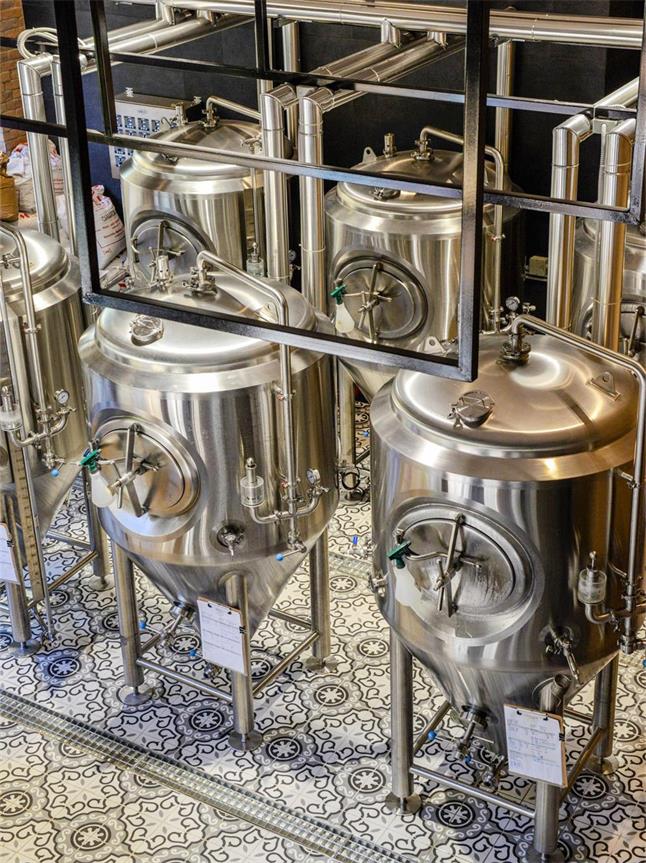
FAQs
What are the standard dimensions for a 5 BBL brite tank?
A typical 5 BBL brite tank has an internal diameter of 30-36 inches and height of 84-96 inches. Exact dimensions can be customized based on brewery needs.
How much glycol is needed for a brite tank cooling jacket?
For a standard 5 BBL brite tank, the glycol reservoir capacity needed is 30-40 gallons to have sufficient volume for heat removal. Glycol concentration is 30% for optimal heat transfer.
Why are brite tanks so much more expensive than fermenters?
Brite tanks require a higher quality internal finish to prevent corrosion. They also need additional features like cooling jackets, pressure controls, cleaning systems which add to cost. The smaller scale compared to fermenters also increases price per unit volume.
Can brite tanks be used for fermentation or conditioning instead of dedicated tanks?
It is possible but not advisable to use brite tanks interchangeably for fermentation or conditioning instead of dedicated tanks. The cleaning requirements, ideal geometry, accessories needed would be very different and make dual purpose use challenging.
Is it better to have multiple smaller brite tanks or one large tank?
Having multiple smaller brite tanks allows handling more beer varieties in parallel. It also provides redundancy. One larger tank reduces equipment cost but provides less flexibility. The ideal strategy is to have a combination of large, medium and small tanks.
Can brite tanks be moved easily for cleaning?
Brite tanks are heavy stainless steel vessels. Those with permanent legs would require tools, machinery to move them for cleaning access. Tanks with casters or wheels enable easier portability by a single operator across short distances. Removable legs also allow relocation.
What are the alternatives to brite tanks for conditioning beer?
Some alternatives to dedicated brite tanks include using the uni-tank approach with fermenter itself, using mobile casks/kegs, repurposing existing storage tanks for conditioning or using fractional tanks that share glycol system cost across multiple units.
How critical is the cone bottom slope angle in brite tanks?
A steep cone bottom slope of around 60 degrees allows complete drainage of beer with minimal residue being left behind. This in turn aids in effective CIP cleaning and reduces contamination risks during batch changeovers.
What are manways in brite tanks and why are they important?
Manways refer to large diameter openings on top of the tank shell for human access when interior inspection or cleaning is needed. Manway size of 18-24 inches is typical in brite tanks for an average sized operator to enter the tank safely.

